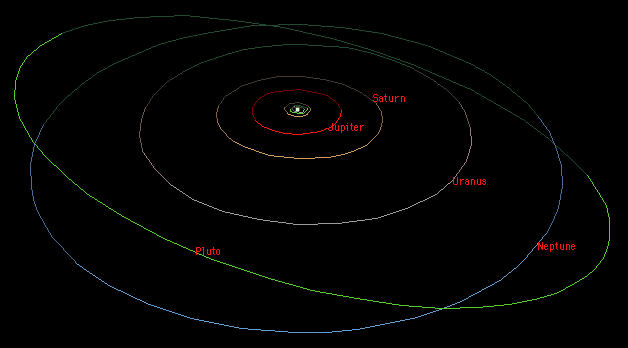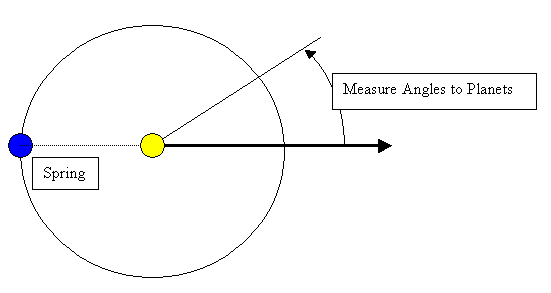
Steps to orient ourselves in the Solar System :
What about the other planets?? : If we look at all the other planets, they all revolve around the Sun in that same direction (if we look down from the top, they go counterclockwise around the Sun). All other planet orbits would then be "tilted" slightly (angle of inclination) relative to that ecliptic plane.
Here are two views of the Solar system .. focusing on the Inner planets mostly, and then the Outer planets:
Inner Planets (Mercury to Mars are "relatively close") :

Outer Planets (from Jupiter on ..) :

Stereo View of the Orbits (Home Planet Web Site!):
If you can view the following image with the "stereo viewing" technique (I "cross eyes" to get a middle image which is the overlap of the two below). If you can properly resolve it, you should get a "3D" view of the orbits. This is looking down on the Solar System at an angle of about 45 degrees from the vertical. On the website, you can change the orientation of the solar system in any way you want!

Orientation along the orbits? : Now that we have the up and down worked out, and can define the orbits of the planets as being tilted relative to the Earth-Sun orbit .. what about figuring out where a planet is around the orbit? If you noticed the stereo image above ... the planet symbols (Greek letters denoting the planets) were placed at certain locations around the orbit - specific to the week of June 19th, 2000. But, how do we specify where around that orbit the planets are? Well, who is doing the observing? We are, here on Earth - thus we pick something relative to us to define the locations of the other planets. What we need is an axis line on the Earth Sun plane - we could then measure angles around the orbit, and angles above the plane from that reference line (starting at the sun). The line is defined as the line in space that results from the Earth and Sun on the first day of Spring (this line direction is called the "point of Aries"). On the first day of Spring, draw a line between the Earth and the Sun ... continue that line out from the Sun - that's the line we use to measure angles to the other planets.

These angles as measured from the Sun are called Heliocentric longitude (around the orbit) or latitude (above the plane).